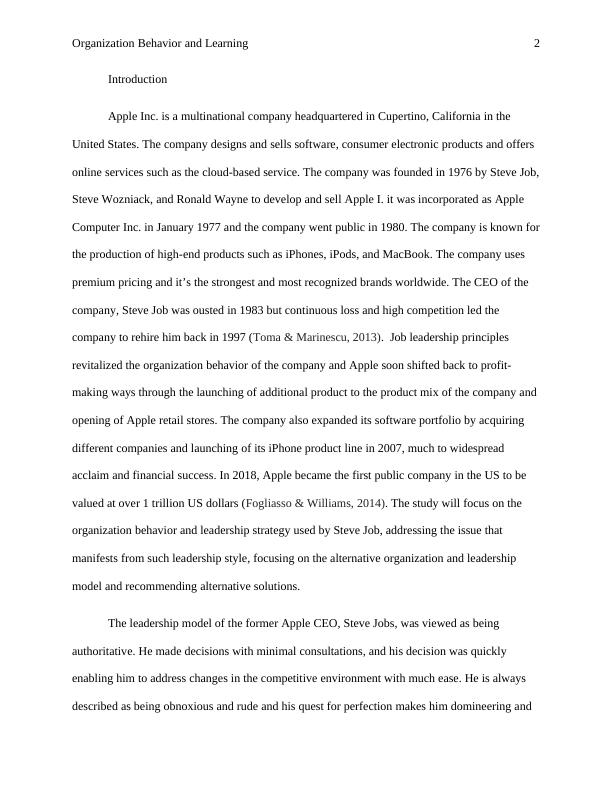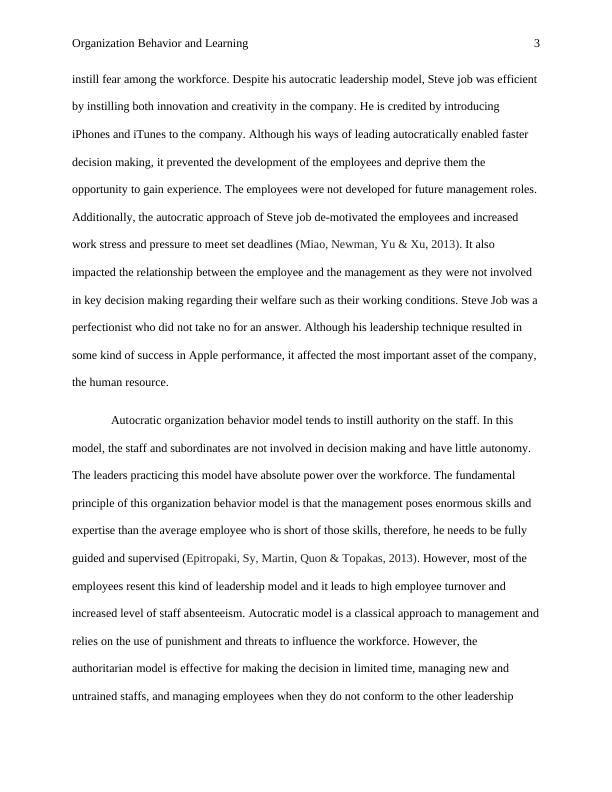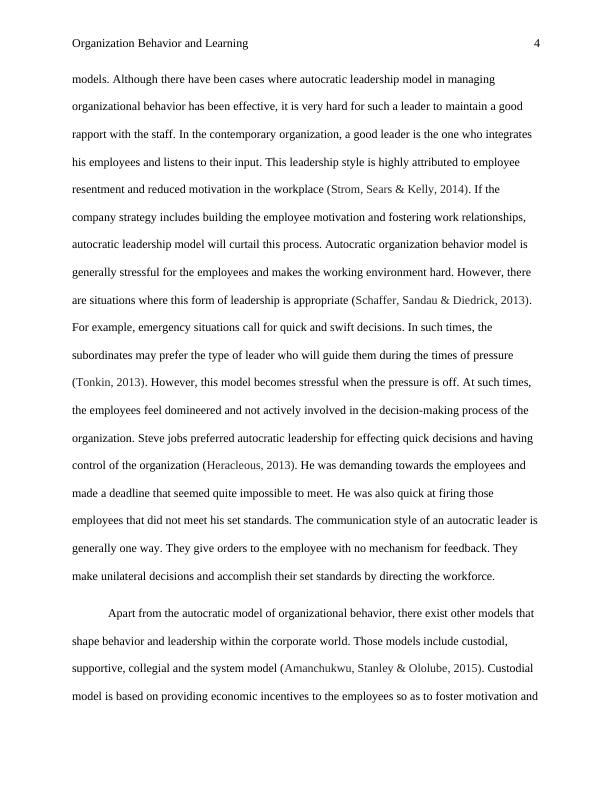Organization Behavior and Learning
Added on 2023-01-19
12 Pages3722 Words99 Views
Running Head: ORGANIZATION BEHAVIOR AND LEARNING 1
Organization Behavior and Learning
Name:
Institution
Organization Behavior and Learning
Name:
Institution

Organization Behavior and Learning 2
Introduction
Apple Inc. is a multinational company headquartered in Cupertino, California in the
United States. The company designs and sells software, consumer electronic products and offers
online services such as the cloud-based service. The company was founded in 1976 by Steve Job,
Steve Wozniack, and Ronald Wayne to develop and sell Apple I. it was incorporated as Apple
Computer Inc. in January 1977 and the company went public in 1980. The company is known for
the production of high-end products such as iPhones, iPods, and MacBook. The company uses
premium pricing and it’s the strongest and most recognized brands worldwide. The CEO of the
company, Steve Job was ousted in 1983 but continuous loss and high competition led the
company to rehire him back in 1997 (Toma & Marinescu, 2013). Job leadership principles
revitalized the organization behavior of the company and Apple soon shifted back to profit-
making ways through the launching of additional product to the product mix of the company and
opening of Apple retail stores. The company also expanded its software portfolio by acquiring
different companies and launching of its iPhone product line in 2007, much to widespread
acclaim and financial success. In 2018, Apple became the first public company in the US to be
valued at over 1 trillion US dollars (Fogliasso & Williams, 2014). The study will focus on the
organization behavior and leadership strategy used by Steve Job, addressing the issue that
manifests from such leadership style, focusing on the alternative organization and leadership
model and recommending alternative solutions.
The leadership model of the former Apple CEO, Steve Jobs, was viewed as being
authoritative. He made decisions with minimal consultations, and his decision was quickly
enabling him to address changes in the competitive environment with much ease. He is always
described as being obnoxious and rude and his quest for perfection makes him domineering and
Introduction
Apple Inc. is a multinational company headquartered in Cupertino, California in the
United States. The company designs and sells software, consumer electronic products and offers
online services such as the cloud-based service. The company was founded in 1976 by Steve Job,
Steve Wozniack, and Ronald Wayne to develop and sell Apple I. it was incorporated as Apple
Computer Inc. in January 1977 and the company went public in 1980. The company is known for
the production of high-end products such as iPhones, iPods, and MacBook. The company uses
premium pricing and it’s the strongest and most recognized brands worldwide. The CEO of the
company, Steve Job was ousted in 1983 but continuous loss and high competition led the
company to rehire him back in 1997 (Toma & Marinescu, 2013). Job leadership principles
revitalized the organization behavior of the company and Apple soon shifted back to profit-
making ways through the launching of additional product to the product mix of the company and
opening of Apple retail stores. The company also expanded its software portfolio by acquiring
different companies and launching of its iPhone product line in 2007, much to widespread
acclaim and financial success. In 2018, Apple became the first public company in the US to be
valued at over 1 trillion US dollars (Fogliasso & Williams, 2014). The study will focus on the
organization behavior and leadership strategy used by Steve Job, addressing the issue that
manifests from such leadership style, focusing on the alternative organization and leadership
model and recommending alternative solutions.
The leadership model of the former Apple CEO, Steve Jobs, was viewed as being
authoritative. He made decisions with minimal consultations, and his decision was quickly
enabling him to address changes in the competitive environment with much ease. He is always
described as being obnoxious and rude and his quest for perfection makes him domineering and

Organization Behavior and Learning 3
instill fear among the workforce. Despite his autocratic leadership model, Steve job was efficient
by instilling both innovation and creativity in the company. He is credited by introducing
iPhones and iTunes to the company. Although his ways of leading autocratically enabled faster
decision making, it prevented the development of the employees and deprive them the
opportunity to gain experience. The employees were not developed for future management roles.
Additionally, the autocratic approach of Steve job de-motivated the employees and increased
work stress and pressure to meet set deadlines (Miao, Newman, Yu & Xu, 2013). It also
impacted the relationship between the employee and the management as they were not involved
in key decision making regarding their welfare such as their working conditions. Steve Job was a
perfectionist who did not take no for an answer. Although his leadership technique resulted in
some kind of success in Apple performance, it affected the most important asset of the company,
the human resource.
Autocratic organization behavior model tends to instill authority on the staff. In this
model, the staff and subordinates are not involved in decision making and have little autonomy.
The leaders practicing this model have absolute power over the workforce. The fundamental
principle of this organization behavior model is that the management poses enormous skills and
expertise than the average employee who is short of those skills, therefore, he needs to be fully
guided and supervised (Epitropaki, Sy, Martin, Quon & Topakas, 2013). However, most of the
employees resent this kind of leadership model and it leads to high employee turnover and
increased level of staff absenteeism. Autocratic model is a classical approach to management and
relies on the use of punishment and threats to influence the workforce. However, the
authoritarian model is effective for making the decision in limited time, managing new and
untrained staffs, and managing employees when they do not conform to the other leadership
instill fear among the workforce. Despite his autocratic leadership model, Steve job was efficient
by instilling both innovation and creativity in the company. He is credited by introducing
iPhones and iTunes to the company. Although his ways of leading autocratically enabled faster
decision making, it prevented the development of the employees and deprive them the
opportunity to gain experience. The employees were not developed for future management roles.
Additionally, the autocratic approach of Steve job de-motivated the employees and increased
work stress and pressure to meet set deadlines (Miao, Newman, Yu & Xu, 2013). It also
impacted the relationship between the employee and the management as they were not involved
in key decision making regarding their welfare such as their working conditions. Steve Job was a
perfectionist who did not take no for an answer. Although his leadership technique resulted in
some kind of success in Apple performance, it affected the most important asset of the company,
the human resource.
Autocratic organization behavior model tends to instill authority on the staff. In this
model, the staff and subordinates are not involved in decision making and have little autonomy.
The leaders practicing this model have absolute power over the workforce. The fundamental
principle of this organization behavior model is that the management poses enormous skills and
expertise than the average employee who is short of those skills, therefore, he needs to be fully
guided and supervised (Epitropaki, Sy, Martin, Quon & Topakas, 2013). However, most of the
employees resent this kind of leadership model and it leads to high employee turnover and
increased level of staff absenteeism. Autocratic model is a classical approach to management and
relies on the use of punishment and threats to influence the workforce. However, the
authoritarian model is effective for making the decision in limited time, managing new and
untrained staffs, and managing employees when they do not conform to the other leadership

Organization Behavior and Learning 4
models. Although there have been cases where autocratic leadership model in managing
organizational behavior has been effective, it is very hard for such a leader to maintain a good
rapport with the staff. In the contemporary organization, a good leader is the one who integrates
his employees and listens to their input. This leadership style is highly attributed to employee
resentment and reduced motivation in the workplace (Strom, Sears & Kelly, 2014). If the
company strategy includes building the employee motivation and fostering work relationships,
autocratic leadership model will curtail this process. Autocratic organization behavior model is
generally stressful for the employees and makes the working environment hard. However, there
are situations where this form of leadership is appropriate (Schaffer, Sandau & Diedrick, 2013).
For example, emergency situations call for quick and swift decisions. In such times, the
subordinates may prefer the type of leader who will guide them during the times of pressure
(Tonkin, 2013). However, this model becomes stressful when the pressure is off. At such times,
the employees feel domineered and not actively involved in the decision-making process of the
organization. Steve jobs preferred autocratic leadership for effecting quick decisions and having
control of the organization (Heracleous, 2013). He was demanding towards the employees and
made a deadline that seemed quite impossible to meet. He was also quick at firing those
employees that did not meet his set standards. The communication style of an autocratic leader is
generally one way. They give orders to the employee with no mechanism for feedback. They
make unilateral decisions and accomplish their set standards by directing the workforce.
Apart from the autocratic model of organizational behavior, there exist other models that
shape behavior and leadership within the corporate world. Those models include custodial,
supportive, collegial and the system model (Amanchukwu, Stanley & Ololube, 2015). Custodial
model is based on providing economic incentives to the employees so as to foster motivation and
models. Although there have been cases where autocratic leadership model in managing
organizational behavior has been effective, it is very hard for such a leader to maintain a good
rapport with the staff. In the contemporary organization, a good leader is the one who integrates
his employees and listens to their input. This leadership style is highly attributed to employee
resentment and reduced motivation in the workplace (Strom, Sears & Kelly, 2014). If the
company strategy includes building the employee motivation and fostering work relationships,
autocratic leadership model will curtail this process. Autocratic organization behavior model is
generally stressful for the employees and makes the working environment hard. However, there
are situations where this form of leadership is appropriate (Schaffer, Sandau & Diedrick, 2013).
For example, emergency situations call for quick and swift decisions. In such times, the
subordinates may prefer the type of leader who will guide them during the times of pressure
(Tonkin, 2013). However, this model becomes stressful when the pressure is off. At such times,
the employees feel domineered and not actively involved in the decision-making process of the
organization. Steve jobs preferred autocratic leadership for effecting quick decisions and having
control of the organization (Heracleous, 2013). He was demanding towards the employees and
made a deadline that seemed quite impossible to meet. He was also quick at firing those
employees that did not meet his set standards. The communication style of an autocratic leader is
generally one way. They give orders to the employee with no mechanism for feedback. They
make unilateral decisions and accomplish their set standards by directing the workforce.
Apart from the autocratic model of organizational behavior, there exist other models that
shape behavior and leadership within the corporate world. Those models include custodial,
supportive, collegial and the system model (Amanchukwu, Stanley & Ololube, 2015). Custodial
model is based on providing economic incentives to the employees so as to foster motivation and

End of preview
Want to access all the pages? Upload your documents or become a member.
Related Documents
Leading in an Organisationlg...
|6
|1201
|1
Organizational Leadership | Reportlg...
|10
|2193
|18
Warren Buffet and Steve Jobs | Reportlg...
|9
|2749
|21
Leading People in Creative Teams SHR0796lg...
|13
|940
|271
Apple Leaderslg...
|4
|759
|28
Apple under the leadership of Steve Jobslg...
|23
|4915
|175
